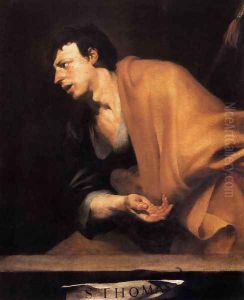Jusepe Martinez Paintings
Jusepe Martínez was a Spanish painter and writer on art, born in Zaragoza in the year 1600. He is often recognized not only for his artistic contributions but also for his significant written work, especially his treatise on painting, which has provided valuable insights into the art of his time. Martínez came from a family with artistic ties; his father was the sculptor Juan Martínez, and under his guidance, Jusepe began his journey in the world of art.
Throughout his career, Martínez worked primarily in Zaragoza and Madrid. He became a well-respected figure in the Spanish art community, known for his skillful execution and his ability to work in various genres, including religious themes, portraits, and still lifes. His painting style was influenced by the prevailing trends of the Baroque period, characterized by dramatic use of light and shadow, a rich color palette, and dynamic compositions. Despite this, Martínez's work was also marked by a certain conservatism, often sticking to the traditions and techniques that he found to be most effective.
One of Martínez's most enduring legacies is his written work, particularly his treatise 'Discursos practicables del nobilísimo arte de la pintura' (Practical Discourses on the Most Noble Art of Painting), which was published posthumously in 1691. This text is considered an important source for understanding the artistic theories and practices of 17th-century Spain. In it, Martínez provides advice on a wide range of topics, from the technical aspects of painting to the moral and philosophical considerations that an artist should bear in mind. This treatise reflects the depth of his knowledge and experience and has been used as a learning tool by artists and scholars alike.
Though Martínez may not be as well-known today as some of his contemporaries, his contributions to Spanish art were significant during his lifetime. His death in Zaragoza in 1682 marked the end of a career that spanned over 80 years, during which time he left a mark as both a talented painter and a thoughtful writer. His works can be found in various churches and collections in Spain, serving as a testament to his artistic skill and his dedication to the craft of painting.
